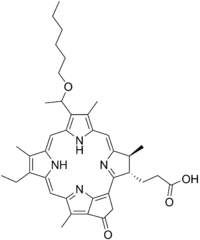2-(1-Hexyloxyethyl)-2-devinyl pyropheophorbide-a
2-(1-Hexyloxyethyl)-2-devinyl pyropheophorbide-a (HPPH) is a photosensitiser chemical that is used in photodynamic therapy.[1]
 | |
| Names | |
|---|---|
| Other names
Photochlor | |
| Identifiers | |
3D model (JSmol) |
|
| Abbreviations | HPPH |
| ChemSpider | |
PubChem CID |
|
| UNII | |
| |
| |
| Properties | |
| C39H48N4O4 | |
| Molar mass | 636.837 g·mol−1 |
Except where otherwise noted, data are given for materials in their standard state (at 25 °C [77 °F], 100 kPa). | |
| Infobox references | |
It is being developed under the brand name Photochlor.
Clinical trials
A phase I/II clinical trial started in 1997 for esophageal cancer.[2]
A phase II trial for non-small cell lung cancer is due to run from 2007 to 2011.[3]
gollark: β you, Gibson!
gollark: THIS IS NOT SUPPOSED TO HAPPEN
gollark: OH BEE ISSUE
gollark: Go install KHTML.
gollark: ++tel dial MatsWidenBacon
References
- Lobel, J; MacDonald, IJ; Ciesielski, MJ; Barone, T; Potter, WR; Pollina, J; Plunkett, RJ; Fenstermaker, RA; Dougherty, TJ (2001). "2-1-hexyloxyethyl-2-devinyl pyropheophorbide-a (HPPH) in a nude rat glioma model: implications for photodynamic therapy". Lasers in Surgery and Medicine. 29 (5): 397–405. doi:10.1002/lsm.10001. PMID 11891727.
- Photodynamic Therapy Using HPPH in Treating Patients With Obstructive Esophageal Tumors
- Photodynamic Therapy Using HPPH in Treating Patients With Advanced Non-Small Cell Lung Cancer That Blocks the Air Passages
This article is issued from Wikipedia. The text is licensed under Creative Commons - Attribution - Sharealike. Additional terms may apply for the media files.